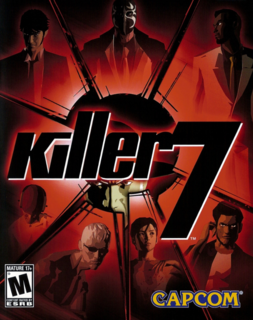Messy. Uneven. Art.
It is the future. The world is united in peace. International highways span oceans and bridge continents and the nuclear powers dispose of their arsenals by detonating them high above the Earth. These low-orbit firework shows can be seen across the globe. A terrorist group of horribly deformed suicide bombers calling themselves the Heaven Smile seeks to create chaos and disturb the worldwide peace. Oh, and the United States just launched a salvo of intercontinental nuclear missiles at Japan.
Killer7's narrative is one part poignant political commentary and one part self-satirizing comedy. It's no wonder Killer7's creator Suda 51, the moniker used by Suda Goichi, and Hideo Kojima have become such good friends. The constant assault of modern political allegories mixed with irreverent humor and abundant, seemingly arbitrary pop culture references, makes for a staggeringly overwhelming experience, leaving players themselves to interpret the narrative as they see fit. The game asks many questions and never really stops to provide any answers, letting the wave of narrative chaos wash over players, hoping they aren't dragged down by the undertow. It's the sort of surreal experience you'd expect from a David Lynch movie rather than a video game.
The Killer7 themselves – a government-funded team of assassins – are the world's only hope against the Heaven Smile. Headed by the wheelchair-bound Harman Smith, the Killer7 may be little more than the seven other elements of his split personality. Each of these characters/personalities, with the exception of Harman, is swappable on the fly and sport unique weapons and special abilities. The well dressed Garcian Smith, for example, is a "cleaner," able to revive dead allies; Kaede Smith comes armed with a deadly pistol and can slit her wrists to bleed on and destroy otherwise insurmountable barriers (obviously).
Each of the Smiths control identically. In what has become the most controversial element of a game filled with F-bombs, child molestation, and brain-washing religious fanatics, Killer7 abandons traditional direction controls in favor of on-the-rails movement. Pressing A (on a GameCube controller) moves your character forward. Pressing B turns your character around 180 degrees. This limited mobility means players will never miss important items or points of interest, but at the same time can't accurately dodge enemies or explore the world at their own discretion. It's a strange and unnecessarily innovative approach to a 3D gameplay mechanic perfected years ago, and will leave you wondering if perhaps the game's movement is different simply for differentness' sake.
Killer7's combat is equally strange and simplistic. Heaven Smiles are invisible by default. However, being the insane mutant suicide bombers that they are, they tend to laugh maniacally, giving away their nearby presence. By switching into a first person perspective, players can then scan the surrounding area for Heaven Smiles, revealing them when within range. Because the enemies are all suicide bombers, their attack patterns differ little from one another as they charge at you with complete contempt for their own lives, detonating in a cel-shaded display of pyrotechnics. By firing at a Heaven Smile's flickering weak point, players can dispatch them in a single shot and collect the fallen enemies' blood to upgrade individual Smiths, increasing their firepower, reload rates, or the potency of special abilities. Though much of the game's combat offers little in terms of variety or challenge, the game's bosses are exceptionally creative (and fun) challenges. One battle plays out like a wild west standoff, another like a creepy game of reverse Pac-Man. The care and love poured into each boss encounter serves as proof that considerably more time went into refining boss mechanics than ensuring normal enemies were any fun to face.
Killer7's simple, nonsensical puzzles feel equally unloved. Like the worst puzzles from Capcom's Resident Evil series, all of Killer7's non-combat challenges involve finding random items and keys to somehow overcome unrelated obstacles. There's a lot of trial and error involved, and little, if any, of it is any fun. These sorts of boringly simple puzzles have interrupted action sequences in video games for years. In Killer7, they do little more than serve as annoying distractions, causing you to wish for more of the lackluster combat. The only puzzle-related highlight comes from the hints delivered by a wide cast of strange and charming characters, most of which are actually the ghosts and spirits of the Killer7's victims.
These lost souls haunt the game's levels and provide useful information, though not always with a smile. You are their murderer, after all. Besides the previously defeated bosses, characters such as the Killer7-obsessing, humorous-shirt-wearing Travis, Harman Smith's first target, provide valuable hints and flesh out the story. Iwazaru, dressed in bondage gear, refers to all members of the Killer7 as his master and adopts a new catchphrase with each level. Susie Sumner, a short-tempered severed head, provides the player with magical elemental rings. Each character is eerily voiced in not quite English, allowing you to recognize maybe one in a dozen words or pick out the occasional rephrasing of the on-screen text. It's a genuinely unsettling effect.
For all its pitfalls, Killer7 is ultimately a game that is stronger than the sum of its parts. Though the combat is mostly dull, the puzzles mostly boring, and the graphics saved only by the cel-shading, the game as a whole succeeds. For all its failings, Killer7 is the sort of game we need more of. Entirely fearless and unwavering in its vision, Killer7 is another game on the short but ever-growing list of art house video games. Its erratic storytelling is strangely captivating, its characters compelling. Killer7 is a game that sticks with you long after you've exhausted the content on the disk, and if that isn't a true measure of success, then I don't know what is.

